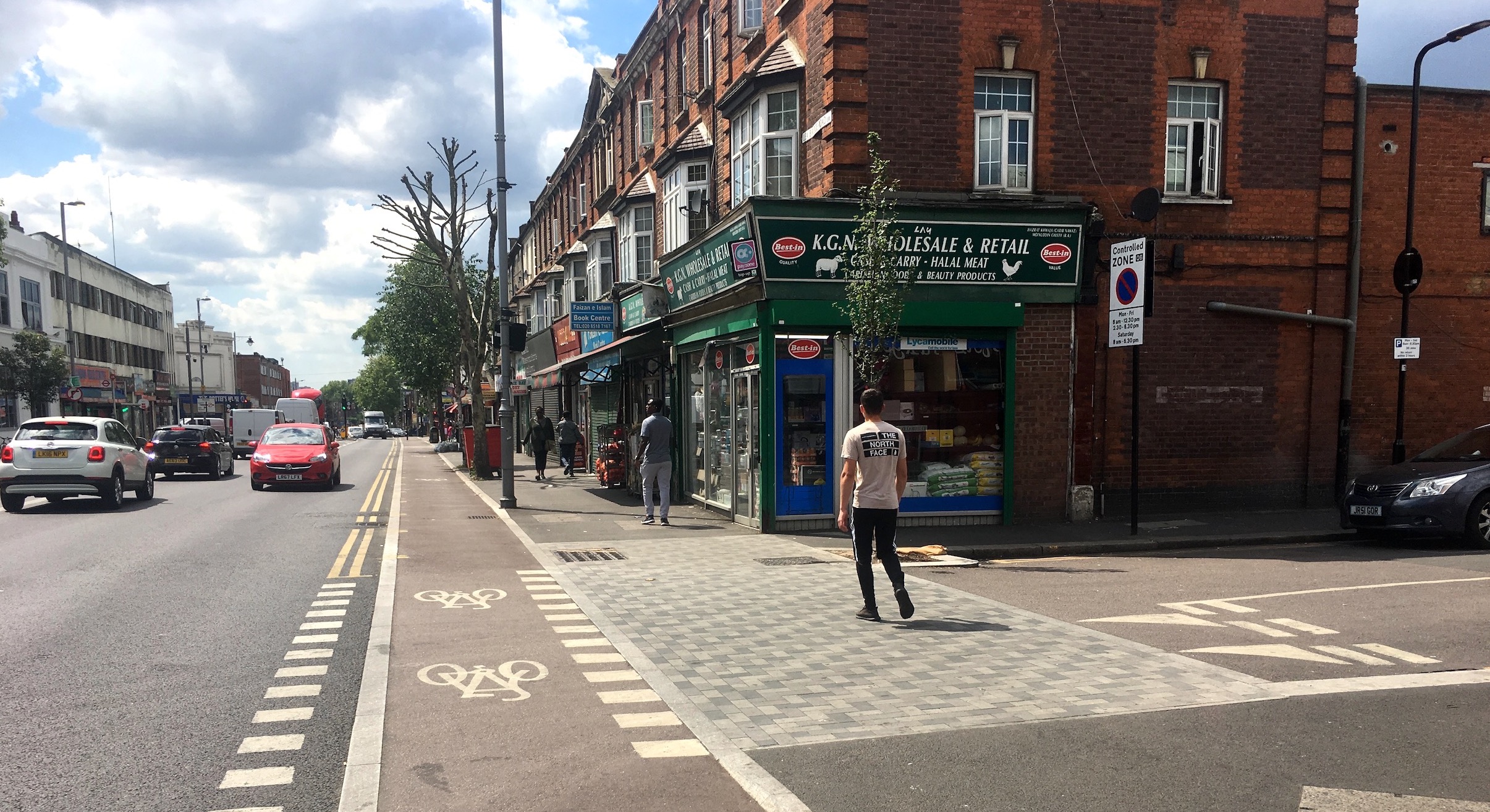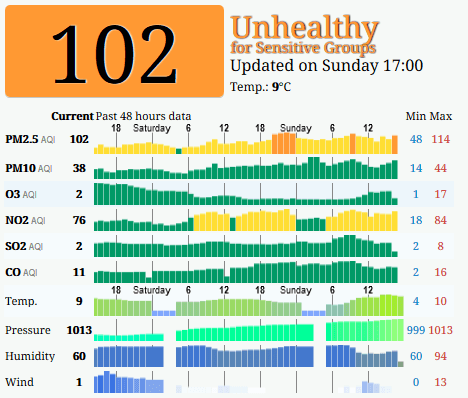Written by Jeremy Leach, Paul Gasson, Robert Molteno and Emma Griffin, London Living Streets
Originally published on the London Living Streets website.
In response to public alarm over climate change, nearly two thirds of London councils had declared a climate emergency by October 2019. While it is relatively straightforward for a council to declare an emergency, it is far more challenging to commit to specific interventions that will deliver big cuts in carbon emissions.
 Lea Bridge Road, Leyton. Waltham Forest Council has given more space for low-carbon, healthy forms of transport
Lea Bridge Road, Leyton. Waltham Forest Council has given more space for low-carbon, healthy forms of transport
To achieve these cuts, London councils must take bolder action on transport. In 2018, transport accounted for a third of the UK’s carbon dioxide emissions, with the large majority from road transport. And while UK CO2 emissions have fallen 39 per cent since 1990, transport emissions are down 3.2 per cent, making it the worst performing sector. In London, total vehicle miles have fallen by a mere 4 per cent between 1993 and 2018.
London Living Streets has identified a range of key policies that local authorities can adopt right now to reduce carbon emissions. Note that these policies have either been adopted by another major global city, by local authorities in London or elsewhere in the UK.
While these policies focus on reducing CO2 emissions, they also have wider relevance and can address issues around public health (physical inactivity and obesity), air pollution, road casualties and social inequality.
Barriers to rapid rollout of measures include lack of funding, and inadequate support from local communities for radical change… and hence a lack of political will. But the impacts of climate change are rapidly becoming more evident and are manifested closer to home, so public support is swelling, enabling local authorities to take bigger and braver steps.
Policies to reduce the use and impact of fossil-fuel-powered motor vehicles
- Roll out controlled parking zones (CPZ) and emissions-based parking charges. Parking charges should a) reflect the full cost of providing road space; b) the value to users of the parking provision; and c) reduce the number of trips in motor vehicles. Controlled parking zones should cover the whole borough and charges should be based on emissions (City of London, Westminster, Islington and Merton all charge diesel vehicles more to park). Parking charges could also discourage residents and visitors from using larger cars such as SUVs. Find out what percentage of your borough’s roads are covered by a CPZ on the London Boroughs Healthy Streets Scorecard.
- Introduce a Workplace Parking Levy (WPL). This helps reduce traffic and generates funds for the borough. Note the success of Nottingham’s Workplace Parking Levy. Levies are also being considered in the London boroughs of Hounslow, Merton, Brent and Camden. TfL has introduced detailed guidance available here.
- An absolute no brainer is for all new residential developments within North & South Circular to be car-free. Where Public Transport Access Levels (PTAL) are low, Local Implementation Plan /Community Infrastructure Levy and Section 106 Agreements should invest in walking, cycling and public transport to bring PTAL levels up to those acceptable for car-free development. Check out TfL’s PTAL Map of London (darker = better public transport coverage.)
- Introduce cargo-bike delivery hubs across the borough. Early opportunities may be in areas with Business Improvement Districts (BIDS), where regeneration is occurring and local town centres. Supplement sustainable last-mile delivery with freight consolidation, local hubs for click-and-collect in addition to parcel collection centres.
- Prioritise the needs of people walking and consider “pedestrian priority” streets in areas with very high footfall (such as around railway stations and local town centres). City of London will make half of its street space pedestrian priority by 2044, where roads will be either fully pedestrianised, or “access only” for vehicles where vehicles, including cycles, give way to people walking.
- Make clear your borough’s support for road user charging and an extension of the ULEZ Ultra-Low Emission Zone to cover all 33 boroughs.
- Consider opportunities for parts of the borough to become car-free. Discussions about the potential for large car-free areas are back on the table. Pontevedra in Spain is a recent example, and Vauban, Freiburg, in Germany an earlier example. Oslo is also fast becoming car-free in its centre. This offers the greatest opportunities for promoting active travel and reducing emissions and improving air quality. Remember there are many places where car ownership is very low. Read Carfree Cities by Joel Crawford (2000) for inspiration.
- Replace vehicle parking spaces with space for climate-resilient urban greening, parklets and cycle parking. Following the policies adopted in Oslo that has dramatically reduced the number of motor vehicle parking spaces.
- Whilst electric vehicles have a role to play in reducing carbon and particulate emissions, they are not the entire solution. Charging points and incentives for electric vehicles should be provided only as a shared communal service, with equivalent incentives for non-motorised traffic. All facilities must be provided off street or on carriageway – never the footway. Read London Living Streets hierarchy for EV infrastructure..
- Set a date by which all vehicles operating under contracts with the council must be petrol/diesel free.
Policies to encourage low-carbon forms of travel
Remember that walking and cycling involve almost zero CO2 emissions and public transport causes lower per capita CO2 emissions than car journeys (European Environment Agency, CO2 Emissions from Passenger Transport).
- Divide the borough into low-traffic neighbourhoods such as being developed in Lewisham and across Waltham Forest. Low-traffic neighbourhoods (LTNs) remove through traffic from residential areas so walking, cycling, living and playing become easier, safer and more attractive. For more information visit our Low-Traffic Neighbourhoods page. Also watch our three-minute video.
- Provide infrastructure that makes cycling a safer and more convenient way to travel. The priority must be protected cycle routes on borough main roads. Remember that 43 per cent of all London’s fatal and serious cycling casualties occur on borough-managed main roads (TFL), but very few of these roads have any protection for people on bikes. (Check out your borough’s progress on cycling infrastructure on this Scorecard.) Seville developed a whole network in a matter of a few years. Storage infrastructure is also essential and includes secure, weather-proof cycle storage facilities in residential areas and estates; and bulk storage facilities at rail and tube stations.
- Expand and prioritise bus travel: Londoners travel by bus more than any other form of public transport. This is also the most economical way of expanding London’s public transport system. Work with Transport for London (TfL) to provide new and innovative forms of bus provision in areas poorly served by public transport, especially in Outer London. Councils can also prioritise bus movement to reduce journey times by introducing more bus lanes and/or bus priority corridors.
- Enhance the infrastructure and public realm for pedestrians. Measures should include improved crossings (on ‘desire lines’, with shorter wait times for people walking and more time to cross); additional road crossings, particularly at bus stops; widened pavements outside stations, in local town centres, and wherever there are high numbers of pedestrians; more public seating, particularly for older residents and parents and carers with buggies; greening of local streets via tree planting and pocket parks.
- Develop a network of walking routes that connect green spaces, town centres, stations, attractions and other amenities. Initial ideas have been proposed by Southwark Living Streets and by London Living Streets for Central London.
- Roll out ‘school streets’ across the borough. School streets transform roads around schools so only people walking or cycling can use them at the start and end of the school day. Given school run traffic makes up 25 per cent of all London’s morning traffic, school streets have huge impact on congestion, as well as on children’s health by reducing air pollution and encouraging children to walk and cycle to school. This idea was pioneered in Hackney and being replicated across London. Use Schools Streets as pilots for wider changes and a wider shift to walking and cycling.
- In order to build community appetite for LTNs, councils can easily implement play streets so communities can close their streets to traffic for a couple of hours once a week to let children play.
It is time London thinks along the lines of Madrid, where wide areas (including main roads) exclude all vehicles apart from those belonging to residents, zero-emissions delivery vehicles, zero-emission taxis, public transport and emergency vehicles. Boroughs could roll out such zones over time, starting with areas with high Public Transport Access Level (PTAL) ratings.
These policies are absolutely vital and urgent if London is to play its part in heading off the worst effects of global warming.
 London Living Streets is the campaigning arm in London of Living Streets, the national charity for everyday walking. The group is dedicated to making London one of the world’s best cities for walking and enjoying streets and public spaces — a city that is genuinely inclusive of all its residents, workers and visitors and not just designed for car users.
London Living Streets is the campaigning arm in London of Living Streets, the national charity for everyday walking. The group is dedicated to making London one of the world’s best cities for walking and enjoying streets and public spaces — a city that is genuinely inclusive of all its residents, workers and visitors and not just designed for car users.
We campaign and develop policy for:
- healthy neighbourhoods that rethink the domination of the car in order to bring life back to our residential streets and encourage more active lifestyles;
- healthy streets and town centres across London that attract more people, reduce reliance on driving and encourage active travel;
- junctions and crossings that improve the experience and safety of pedestrians regardless of age or disability;
- a Central London Walking Network that prioritises and links the capital’s ancient street network for walking; and
- a fair system of road user charging across London that reflects the real costs of driving and reduces traffic volumes.





